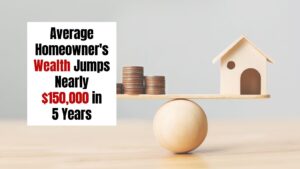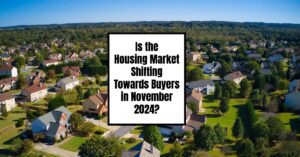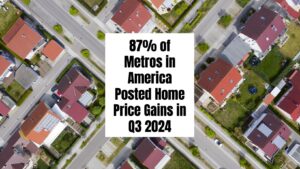
Have you been dreaming of owning your own home? Perhaps you've been saving up for a down payment, or maybe you're just starting to think about your future housing situation. Well, the 2025 housing market predictions suggest that while there will be more home sales due to pent-up demand, many people like you might end up renting instead. Higher home prices and mortgage rates will make homeownership a challenge, while rental prices stay relatively flat and wages continue to rise, making renting a more affordable choice for many.
Let me tell you, the housing market has been a rollercoaster ride over the past few years. The pandemic created a surge in demand for houses as people sought more space and stability. Interest rates dropped, which made it easier for some to get into the housing market. But as the economy recovered, interest rates have steadily risen, and it seems that trend might continue into 2025.
In this article, I'll dive into the 2025 housing market predictions from Redfin, a real estate company that provides valuable insights into the housing market. We'll explore the various factors that are expected to shape the market, including rising home prices, fluctuating mortgage rates, and the shift in consumer preferences toward renting. I'll also share my thoughts and expertise on the topic, having spent many years in the real estate market.
Redfin’s Key Housing Market Predictions for 2025
Based on Redfin's economists, the 2025 housing market will be a complex one. They anticipate that there will be an increase in the number of homes sold, mainly due to the pent-up demand that developed during and after the pandemic. However, they also predict that many people will find themselves unable to afford homeownership, leading to an increase in the number of renters.
Here's a breakdown of the key predictions:
1. Home Prices Will Rise 4% in 2025
Redfin expects the median U.S. home sale price to rise steadily throughout 2025, ending the year 4% higher than it was in 2024. This increase is expected to be similar to the latter half of 2024 because the supply of new homes isn't expected to keep up with the demand.
From my experience, this isn't a surprising prediction. The limited supply of homes for sale has been a major factor in the recent surge in housing prices. And, as long as more homes aren't built, demand is likely to keep prices climbing.
2. Mortgage Rates Will Remain Near 7%
Mortgage rates are predicted to stay high throughout 2025, fluctuating around 6.8%. Redfin's economists believe that if certain economic factors play out, like the potential impact of tax cuts and tariffs, the Federal Reserve might only decrease its benchmark interest rate a couple of times in 2025. This would mean that mortgage rates stay relatively high.
While there's a possibility that rates could drop to around 6% if the economy slows down, or if there are changes in policy, there's also the potential for rates to increase if inflation grows or the government deficit expands.
3. There Will Be More Home Sales in 2025 Than 2024
Redfin predicts that the annual rate of existing home sales will increase to between 4.1 million and 4.4 million. That's a rise of 2% to 9% compared to 2024.
But, the prediction comes with a range because the increase in sales depends on a variety of factors. If mortgage rates and low inventory stay high, the increase in sales might be small. But if rates come down more than expected, and the strong home buying demand that we saw in the last few months continues, then sales could rise significantly.
In my opinion, the market is volatile right now, and the rate at which it goes up and down is unprecedented. We've witnessed strong buyer demand in the face of rising interest rates, and that's a bit unusual. But, at the same time, we still have a pretty limited inventory of homes for sale, so there's still a lot of pressure on prices.
4. 2025 Will Be a Renter’s Market
While home prices are going up and mortgage rates are likely to stay high, the 2025 housing market is expected to be more favorable for renters. Renters can expect rent prices to stay pretty much the same as 2024. At the same time, wages are expected to increase, which will make rent payments more manageable for the average person.
There's also the possibility that there will be more new rental units coming onto the market as new construction projects that were started during the pandemic are completed. This could mean that there will be more rental units available than people looking for them, and landlords might try to attract and keep tenants by offering things like free parking, a month of free rent, or better amenities.
5. Fewer Construction Regulations Will Lead to More Homebuilding
Redfin anticipates that homebuilders will likely create more single-family homes in 2025. This prediction is based on the idea that there will be fewer regulations for builders. But it's important to remember that it might take several years for any increase in homebuilding to significantly improve affordability.
While relaxed regulations could also lead to more construction of multi-family housing, there are also some factors that could potentially slow down construction. High interest rates and a potential decrease in immigration could make it harder for builders to get financing or find workers.
6. Wealthy People Will Pay Less to Buy and Sell Homes As Commissions Decline Slightly
With the introduction of new rules from the National Association of Realtors, Redfin expects real estate commissions to go down slightly, especially for expensive homes and in competitive markets. The amount of change is difficult to predict, but the prediction is that the rules will lead to more negotiation, especially in markets where there is a lot of competition for buyers.
7. The Real Estate Industry Will Consolidate
Redfin predicts that the real estate industry will see more companies merging and buying each other up. This is based on the belief that the Federal Trade Commission will be more willing to approve mergers and acquisitions under the new administration.
8. Climate Risks Will Be Priced Into Individual Homes, Especially in Coastal Florida
As climate change creates more natural disasters, such as hurricanes, wildfires, and floods, Redfin thinks the housing market will start to reflect these risks, especially in areas that are particularly vulnerable, such as coastal Florida, parts of California, and Texas.
9. Mayors in Blue Cities Will Help Reverse the Flight From Urban Centers
Some major cities in “blue states” have taken steps to try to attract residents back to their cities and increase safety and stability. In my opinion, these efforts may start to reverse the decline in population that we've seen in some major cities in recent years.
10. Gen Z Will Rewrite the American Dream, Cutting Homeownership From the Script
Gen Zers might be choosing to delay homeownership, prioritizing different financial goals. Instead of aiming for homeownership, many young people might opt to focus on other ways of building wealth.
My Take on the 2025 Housing Market Predictions
I've been involved in the real estate market for several years, and I've seen firsthand how things can change quickly. Redfin's predictions are based on sound economic reasoning, but it's important to remember that predictions aren't guarantees.
Based on my experience, I believe that the predictions for rising home prices and potentially flat or slightly declining rental prices are likely to hold true. As long as interest rates remain elevated, and the inventory of homes for sale stays low, there will likely be upward pressure on home prices. And, if we do see a surplus of new rental units hitting the market, rents could even decrease.
I think that the prediction regarding the impact of climate change on the housing market is also something to watch closely. The climate is changing at an accelerated rate, and the real estate market will likely start to incorporate the risks associated with natural disasters in a larger way.
The Role of Technology
I think it's also important to consider the role that technology will play in the 2025 housing market. We're likely to see an increase in the use of virtual and augmented reality for showing homes and virtual tours. The increased use of AI-powered tools and services to help buyers and sellers will reshape the way we look at and interact with the real estate market.
The Importance of Personal Finance
In addition to the economic factors discussed above, it's also important for individuals to consider their personal financial circumstances when making housing decisions. If you're considering buying a house, you need to have a solid grasp of your financial situation, including your income, debt, and credit score.
If you're not sure if you can afford to buy a home, consider renting for a while. Renting can be a good option if you're not ready to commit to a mortgage or if you're unsure about your job security.
What Does This Mean for You?
The 2025 housing market predictions suggest that it might be a good time to be a renter. If you're currently renting, you may find that your rent payments become more manageable, especially as wages increase. You also may find that you have more options for housing because of the possibility of new rental units hitting the market.
On the other hand, if you're dreaming of buying a house, you should keep an eye on the market. If home prices continue to rise, and mortgage rates stay high, you might need to save up more for a down payment or consider buying a smaller or less expensive house.
It's important to carefully weigh the pros and cons of buying versus renting before making a decision. You may want to speak with a financial advisor or real estate agent to get a better idea of what your options are and which path might make the most sense for you.
Final Thoughts
The 2025 housing market is expected to be one of increasing home sales, but also one where many buyers will decide to rent instead of buy because of higher housing costs. While there are some uncertainties about the future of the housing market, it's clear that the economic conditions will play a significant role in shaping the market in the year ahead.
As always, it's vital to make informed decisions and to work with trusted professionals who can help you navigate the complexities of the real estate market. I hope this article has given you a better understanding of what to expect in the coming years and some food for thought as you begin to plan your own housing journey.
Partner with Norada, Your Trusted Source for Turnkey Investment Properties
Discover high-quality, ready-to-rent properties designed to deliver consistent returns. Contact us today to expand your real estate portfolio with confidence.
Reach out to our investment counselors:
(949) 218-6668 | (800) 611-3060
Recommended Read:
- Housing Market Predictions for Biggest Winners & Losers in 2025
- Housing Market Predictions for 2025 and 2026 by NAR Chief
- Housing Market Forecast for the Next 2 Years: 2024-2026
- 87% of Metros in America Posted Home Price Gains in Q3 2024
- Housing Market Predictions for Next Year: Prices to Rise by 4.4%
- Housing Market Predictions for the Next 4 Years: 2024 to 2028
- Real Estate Forecast Next 5 Years: Top 5 Predictions for Future
- Real Estate Market Predictions 2025: What to Expect
- Is the Housing Market on the Brink in 2024: Crash or Boom?
- 2008 Forecaster Warns: Housing Market 2024 Needs This to Survive
- Real Estate Forecast Next 10 Years: Will Prices Skyrocket?
- Housing Market Predictions for Next 5 Years (2024-2028)










